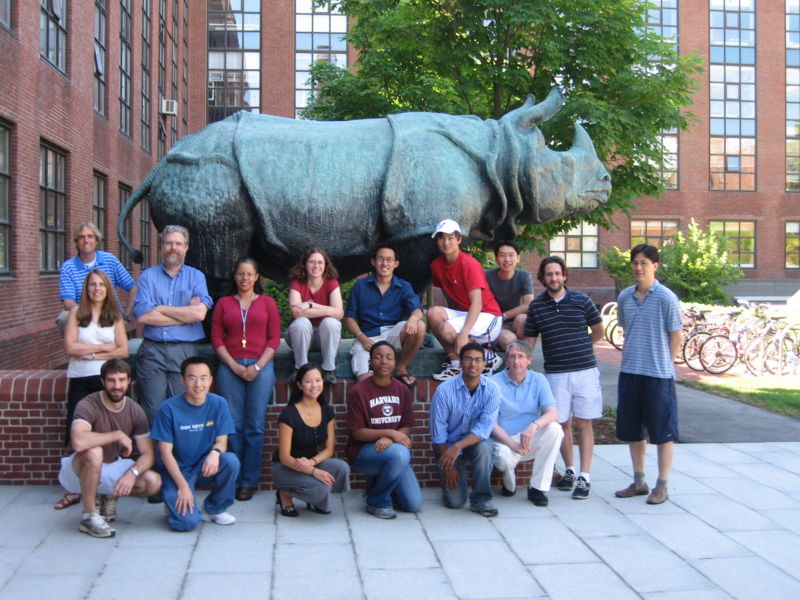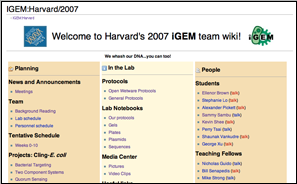Harvard
From 2007.igem.org
(→The Harvard University 2007 iGEM Team) |
|||
| Line 36: | Line 36: | ||
<p style = "font-size:150%;">Cling-<i>E. Coli</i></p> | <p style = "font-size:150%;">Cling-<i>E. Coli</i></p> | ||
| - | #[https://2007.igem.org/Harvard | + | #[https://2007.igem.org/wiki/index.php?title=Harvard&action=submit#Bacterial_Targeting Bacterial Targeting] |
| - | #[https://2007.igem.org/Harvard | + | #[https://2007.igem.org/wiki/index.php?title=Harvard&action=submit#Quorum_Sensing Quorum Sensing] |
| - | #[https://2007.igem.org/Harvard | + | #[https://2007.igem.org/wiki/index.php?title=Harvard&action=submit#Fec_Signal_Transduction Fec Signal Transduction] |
<br> | <br> | ||
As of the end of the summer, enriched targeting was successfully demonstrated with known tagged sender and receiver cells. Separately, the quorum system with multiple types of promoters and reporters was well characterized. We are on our way toward a combined targeting-quorum system in the near future. In addition, targeting with random libraries to various substrates should also be achieved. | As of the end of the summer, enriched targeting was successfully demonstrated with known tagged sender and receiver cells. Separately, the quorum system with multiple types of promoters and reporters was well characterized. We are on our way toward a combined targeting-quorum system in the near future. In addition, targeting with random libraries to various substrates should also be achieved. | ||
Revision as of 16:36, 14 October 2007
| Harvard University 2007 iGEM Team | ||
Students
Education Advisor
|
Teaching Fellows
Faculty Advisors
| |
The Harvard University 2007 iGEM Team
This year Harvard's team consisted of 8 undergraduate students, with backgrounds in molecular and cellular biology, biochemistry, and computer science. With the help of 6 faculty advisers and 4 teaching fellows, plus one education advisor, they devised and executed a single project with three subsections.
Cling-E. Coli
As of the end of the summer, enriched targeting was successfully demonstrated with known tagged sender and receiver cells. Separately, the quorum system with multiple types of promoters and reporters was well characterized. We are on our way toward a combined targeting-quorum system in the near future. In addition, targeting with random libraries to various substrates should also be achieved.
Eventually, our project may have applicability in medical imaging and localized drug synthesis and release. Theoretically, if our project is successful, we demonstrate that bacteria (or other microorganisms) can be targeted specifically to a certain tumor cell. At a certain density, quorum sensing may allow for the bacteria to emit a signal that can be detected by medical imaging devices. If the reporter gene encoded for drugs or vitamins, synthesis can also be evoked through enriched targeting. Furthermore, binding through a modified Fec system may allow for binding alone to transduce a signal and elicit a response in the cells.
Bacterial Targeting
Project Overview
- The motivation for this part of the project was to engineer bacteria to adhere to targets with a high degree of specificity.
- Initial targeting was done by displaying histidine and strep2 tags on the E. coli surface via fusion with LppOmpA and AIDA-1 vehicles, and screens were performed with binding to their known nickel and streptavidin targets, respectively.
- After characterization and high enrichment with these known substrates, random libraries were inserted into LppOmpA and AIDA-1 constructs for screening peptides with affinity for novel targets. As we proceed with this experiment, we hope to characterize sequences that lend specificity to calmodulin and EGF.
- We also tried to utilize the same enrichment strategy with cells that were cotransformed with both AIDA-1-fused tags and quorum-sensing genes (see below).
Methods
Results
Conclusions and future plans
References
Quorum Sensing
Project Overview
- The motivation for this part of the project was to effect downstream activity after E. coli bind to a particular substrate, using the luxI/luxR quorum-sensing system from Vibrio fischeri, which would turn on after the bacteria localize to the target.
- Lux quorum-sensing works like a system of sender and receiver. LuxI codes for a protein that produces 3-oxo-hexanyl homoserine lactone, or OHHL, which can diffuse freely through the surface of E. coli into the environment and into other E. coli. LuxR encodes for a protein which does not diffuse across the membrane and, when bound to OHHL, upregulates the luxpR promoter. So luxI-producing bacteria (senders) produce OHHL that diffuses into luxR-producing bacteria (receivers) where OHHL and luxR turn on luxpR promoter. This only occurs at a certain concentration of OHHL, thus a certain concentration of cells (quorum) is required.
- Initial characterizations of the luxI/luxR system and quorum activity were made using GFP and RFP reporters. Two approaches were taken to quorum sensing. (1) A luxI/luxR production system in one cell would be simpler, but it's possible that the cells might self-induce. (2) luxI and luxR production in separate cells would ensure no self-induction, but it requires monitoring two populations of cells.
Methods
Results
- We were able to demonstrate that the sender-receiver system in one cell was not self-inducing but acted with quorum activity.
- Quorum activity was also detected with the separate sender and receiver cells.
- By collaborating with the bacterial targeting subteam, we have evidence that tagged (targeted) senders and recievers are localizing to the beads, and were able to demonstrate high levels of targeted enrichment.
Enrichment Results<p>
- We are still in progress of characterizing the cell and bead density required to reach quorum levels.
Fec Signal Transduction
Project Overview
- The motivation for this part of the project was also to effect downstream activity after E. coli binds to a target, but through signal transduction of the Fec system.
- The Fec system of E. coli is unique in its ability to bind to iron and produce a signal to control gene expression. By computationally modifying the FecA receptor on the outer membrane of E. coli, we hoped to bind other specific targets and transduce a reporting signal. The goals for this subproject also include insertion of random peptide libraries into the FecA protein.
Methods
Results
Conclusions and future plans
References
<p style = "font-size:120%;">Click the picture, or click [http://openwetware.org/wiki/IGEM:Harvard here] for the more detailed Harvard iGEM 2007 wiki.

